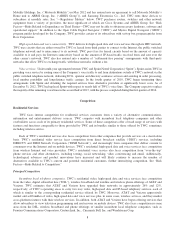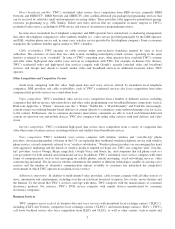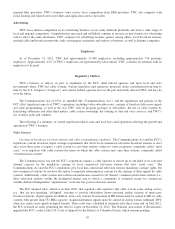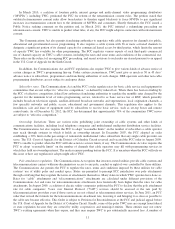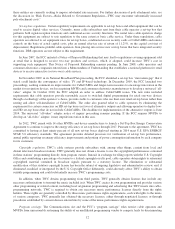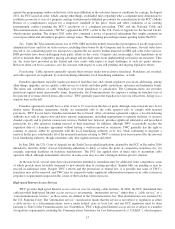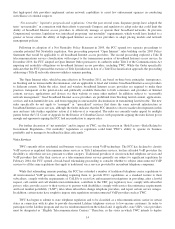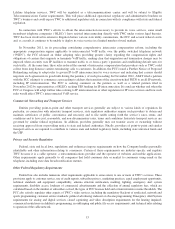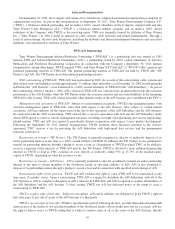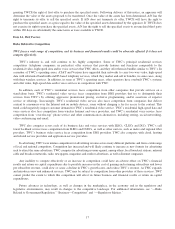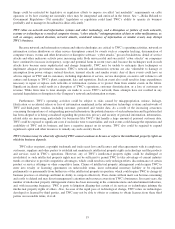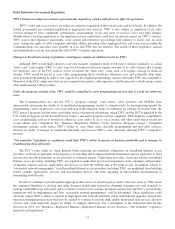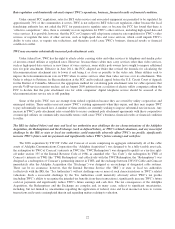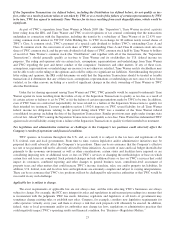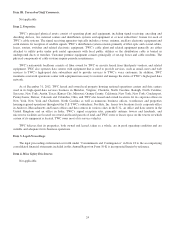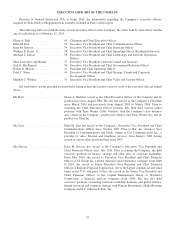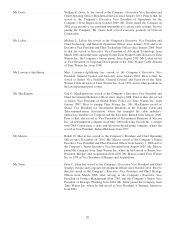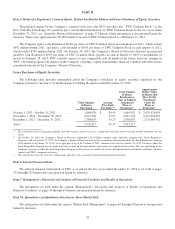Time Warner Cable 2012 Annual Report Download - page 28
Download and view the complete annual report
Please find page 28 of the 2012 Time Warner Cable annual report below. You can navigate through the pages in the report by either clicking on the pages listed below, or by using the keyword search tool below to find specific information within the annual report.TWC faces risks relating to competition for the leisure and entertainment time and discretionary spending of audiences,
which has intensified in part due to advances in technology and changes in consumer expectations and behavior.
In addition to the various competitive factors discussed above, TWC’s business is subject to risks relating to increasing
competition for the leisure and entertainment time and discretionary spending of consumers. TWC’s business competes with
all other sources of entertainment and information delivery. Technological advancements, such as new video formats and
Internet streaming and downloading on televisions, computers and mobile devices, many of which have been beneficial to
TWC’s business, have nonetheless increased the number of entertainment and information delivery choices available to
consumers and intensified the challenges posed by audience fragmentation. Furthermore, due to consumer electronics
innovations, consumers are more readily able to watch Internet-delivered content on television sets and mobile devices. The
increasing number of choices available to audiences, including low-cost or free choices, could negatively impact not only
consumer demand for TWC’s products and services, but also advertisers’ willingness to purchase advertising from TWC.
TWC’s failure to effectively anticipate or adapt to new technologies and changes in consumer expectations and behavior
could significantly adversely affect TWC’s competitive position and its business and results of operations.
Risks Related to TWC’s Operations
A prolonged economic downturn, especially a continued downturn in the housing market, may negatively impact TWC’s
ability to attract new subscribers and generate increased revenue.
The U.S. economy has experienced a protracted slowdown, and the future economic environment may continue to be
challenging. A continuation or further weakening of these economic conditions could lead to further reductions in consumer
demand for the Company’s services, especially premium and On-Demand services and DVRs, and a continued increase in
the number of homes that replace their video service with Internet-delivered and/or over-air content, which would negatively
impact TWC’s ability to attract customers, increase rates and maintain or increase revenue. In addition, providing video
services is an established and highly penetrated business. TWC’s ability to gain new video subscribers is dependent to a large
extent on growth in occupied housing in TWC’s service areas, which is influenced by both national and local economic
conditions. In the absence of renewed growth in the number of occupied homes in TWC’s operating areas, TWC’s ability to
gain new video subscribers may be negatively impacted.
TWC’s business is characterized by rapid technological change, and if TWC does not respond appropriately to
technological changes and changes in consumer expectations and behavior, its competitive position may be harmed.
TWC operates in a highly competitive, consumer-driven and rapidly changing environment. Its success is, to a large
extent, dependent on its ability to acquire, develop, adopt, upgrade and exploit new and existing technologies to address
consumers’ changing demands and distinguish its services from those of its competitors. TWC may not be able to accurately
predict technological trends or the success of new products and services. If TWC chooses technologies or equipment that are
less effective, cost-efficient or attractive to its customers than those chosen by its competitors, or if TWC offers services that
fail to appeal to consumers, are not available at competitive prices or that do not function as expected, TWC’s competitive
position could deteriorate, and TWC’s business and financial results could suffer.
The ability of TWC’s competitors to introduce new technologies, products and services more quickly than TWC may
adversely affect TWC’s competitive position. Furthermore, advances in technology, decreases in the cost of existing
technologies or changes in competitors’ product and service offerings may require TWC in the future to make additional
research and development expenditures or to offer at no additional charge or at a lower price certain products and services
TWC currently offers to customers separately or at a premium. In addition, the uncertainty of the Company’s ability and the
costs to obtain intellectual property rights from third parties could impact TWC’s ability to respond to technological
advances in a timely and effective manner.
Regulation may limit TWC’s ability to make required investments or adopt business models that are needed to continue to
provide robust high-speed data service.
The rising popularity of bandwidth-intensive Internet-based services has increased the demand for and usage of TWC’s
high-speed data service. Examples of such services include the delivery of video via streaming technology and by download,
peer-to-peer file sharing services and gaming services. As demand continues to grow, TWC will need flexibility to develop
pricing and business models that will allow it to respond to such changing consumer uses and demands and, if necessary, to
invest more capital than currently expected to increase the bandwidth capacity of its systems. TWC’s ability to do these
18


